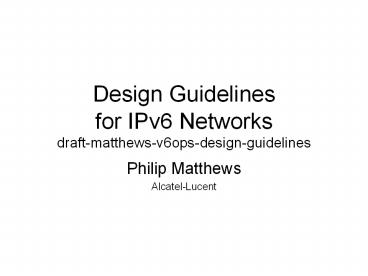Design Guidelines for IPv6 Networks draft-matthews-v6ops-design-guidelines - PowerPoint PPT Presentation
Title:
Design Guidelines for IPv6 Networks draft-matthews-v6ops-design-guidelines
Description:
Design Guidelines for IPv6 Networks draft-matthews-v6ops-design-guidelines Philip Matthews Alcatel-Lucent – PowerPoint PPT presentation
Number of Views:187
Avg rating:3.0/5.0
Title: Design Guidelines for IPv6 Networks draft-matthews-v6ops-design-guidelines
1
Design Guidelines for IPv6 Networksdraft-matthew
s-v6ops-design-guidelines
- Philip Matthews
- Alcatel-Lucent
2
What?
- Advice to designers of IPv6 networks.
- Discusses questions that often arise in IPv6 or
dual-stack network design. - Ex Use LLAs or GUAs for eBGP sessions?
- For each question
- List all the options
- Discuss pros and cons
- Describe current practice or make recommendation
- Lower-level than existing docs on Deploying IPv6
in ltfoogt-type networks. - -00 version very preliminary
3
Scope
- No Addressing Plan section
- See RFC 5375 (Time to revise?)
- Unicast only, for now
- No DNS etc, for now
- Separate doc?
- MPLS currently in
4
Next-hop address in static route?
- In a static route
- (a) Use far-ends LLA addresses as next-hop, OR
- (b) Use far-ends GUA/ULA?
- RFC 4861 (ND for IPv6) section 8 specifies (a)
- A router MUST be able to determine the
link-local address for each of its neighboring
routers in order to ensure that the target
address in a Redirect message identifies the
neighbor router by its link-local address. For
static routing, this requirement implies that the
next-hop router's address should be specified
using the link-local address of the router. - This implies (b) will prevent a router from
sending redirects. Typically only a problem when
2 routers and 1 hosts are connected to same
LAN, and where one router might redirect to the
other (e.g., not running VRRP). - When redirects are not a concern, either (a) or
(b) can be used. - Q for WG Any other pros/cons?
- My sense is that most operators do (b).
- Suggest 6MAN update 4861?
5
Mix or separate v4 and v6?
- On a point-to-point router link
- (a) Mix v4 and v6, OR
- ? One L3 interface at each end
- (b) Separate v4 and v6 onto separate (logical)
links? - ? Two L3 interfaces at each end
- Pros for Option (a)
- Better scaling. Also lower cost if physical,
rather than logical, links are used for option
(b). - Pros for Option (b)
- Easier to measure traffic levels of each
individual protocol. This is difficult today with
option (a). - Most operators do (a) today, but (b) is also
used. - Q for WG Any other pros/cons? Recommend (a)?
6
LLA or GUA/ULA addressing ?
- On a point-to-point router link
- (a) Use LLA addresses only (unnumbered), OR
- (b) Also use GUA/ULA addresses?
- Pros for unnumbered links
- Ease of configuration (less so if using manual
LLA assignment). - Security interfaces cannot be attacked off-link
- Cons for unnumbered links
- Cannot ping interfaces from an off-link device.
- Traceroute returns loopback/system address rather
than interface address. - On some routers, LLA will change after line card
swap unless hard-coded. - Cannot identify interface or link by just LLA (in
database, email, etc.) - Because of the cons, operators do (b) today.
- Q for WG Any other pros/cons? Recommend (b)?
7
eBGP with LLA or GUA endpoints?
- For an eBGP session
- (a) Use LLA addresses as endpoints, OR
- (b) Use GUA addresses as endpoints ?
- Note This is about the eBGP endpoints, and not
whether the link has GUAs. - Pros for option (a)
- Security against off-link attacks
- Cons for option (a)
- Need next-hop-self at both endpoints (some
routers do this automatically) - Cannot refer to BGP session using just addresses,
something operators are used to doing - Inconsistency between v4 and v6 when doing
dual-stack - On some routers, eBGP with LLAs is more complex
to configure. - Strict interpretation of RFC 2545 (MP-BGP for
IPv6) can be seen as forbidding eBGP sessions
with LLA endpoints, as it requires the next-hop
field to contain a GUA. - Most operators today use (b).
- Q for WG Any other pros/cons? Recommend (b)?































